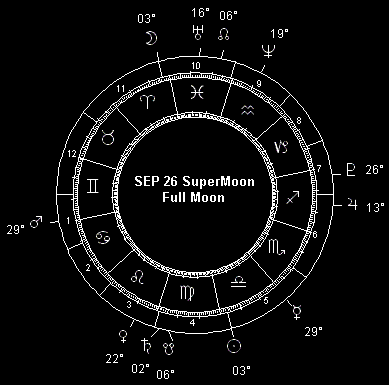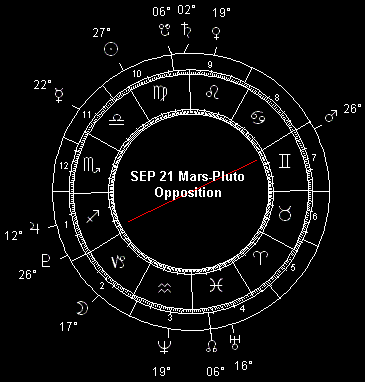If you were expecting some kind of sun sign nonsense, forget about it. This is real astrology for the real world. If it's real astrology for yourself that you want, you can get it by phone or in print. And if you need help deciphering the astrological glyphs in the graphics accompanying this article, see Astroglyphs: Astrological Symbols Guide. Please note: this forecast is expressed in terms of Universal Time (UT).
Time makes more converts than reason.
-- Thomas Paine
 September is HUGE, with geophysical surges accompanying the solar eclipse on the 11th and the SuperMoon at the end of the month - just to point out two of the 800-pound gorillas in the room. Powerful disturbances in the crust, seas and skies of Planet Earth are on tap, from destructive storms with high winds and heavy precipitation (plus accompanying floods, landslides and such); as well as moderate to severe earthquakes (magnitude 5 and up) and volcanic eruptions. This won't be the only story for the month, but it's going to be one of the big ones.
September is HUGE, with geophysical surges accompanying the solar eclipse on the 11th and the SuperMoon at the end of the month - just to point out two of the 800-pound gorillas in the room. Powerful disturbances in the crust, seas and skies of Planet Earth are on tap, from destructive storms with high winds and heavy precipitation (plus accompanying floods, landslides and such); as well as moderate to severe earthquakes (magnitude 5 and up) and volcanic eruptions. This won't be the only story for the month, but it's going to be one of the big ones.
The partial solar eclipse of the 11th, while over and done with in less than four hours, sets up a geophysical stress window that runs all the way from the 4th through the 18th - which gets extended into the 20th thanks to the south lunar declination peak on the 19th. That's the longest continuous period for increased risk of severe storms and major seismic activity all month - the longest in a good six months, as far as that goes. The 5th (when Luna hits peak declination north of the equator), the 11th (the eclipse itself), the 12th (when the Moon crosses the celestial equator from north to south) and the 19th are bound to be among the focal points during this prolonged solar eclipse stress window. Watch the sky, keep tuned into the weather reports, and have your emergency preparations done and ready.
It's worth noting that the solar eclipse storm and seismic emphasis is planetary in scale, and therefore planet-wide in scope. So be ready wherever you happen to be during this period, just in case. That said, there are a few possible clues to areas of particular vulnerability during this cycle. For one thing, there's the eclipse's zone of visibility, which in this case is pretty well restricted to the southern three-fourths of South America, along with parts of Antarctica. But there's also astro-locality mapping to consider. In that regard, West Africa and New Zealand are the only places under the longitudinal danger zone for the September 11 solar eclipse. Howevere the astro-map for that event shows a risky looking horizon line through the Rockies from Canada down through Mexico in the New World, passing through India, western China and northeasterly on through Russia in the Old. Anyone in any of the indicated higher-risk zones would do well to be on special alert status of course. Bear in mind that the sky covers us all, so none of us is beyond the reach of stormy weather. And inasmuch as seismic and storm activity can disrupt the infrastructure on which we all depend, one doesn't have to take a direct hit to feel the pain. (For example, energy resources can easily be cut off or diminished by a natural disaster.)
 No sooner do we get the eclipse window behind us than the SuperMoon window opens up, closing out September on another turbulent note. SuperMoon is a term I coined in a 1979 article for Dell Publishing Company's HOROSCOPE magazine, describing what is technically called a perigee-syzygy; a new or full moon (syzygy) which occurs with the Moon at or near (within 90% of) its closest approach to Earth in a given orbit. In short, Earth, Moon and Sun are all in a line, with Moon in its nearest approach to Earth. Historically, SuperMoon alignments have come within a few days of some of the most destructive storms and earthquakes on record. For more on SuperMoons, see my article in the October/November 2007 issue of The Mountain Astrologer magazine.
No sooner do we get the eclipse window behind us than the SuperMoon window opens up, closing out September on another turbulent note. SuperMoon is a term I coined in a 1979 article for Dell Publishing Company's HOROSCOPE magazine, describing what is technically called a perigee-syzygy; a new or full moon (syzygy) which occurs with the Moon at or near (within 90% of) its closest approach to Earth in a given orbit. In short, Earth, Moon and Sun are all in a line, with Moon in its nearest approach to Earth. Historically, SuperMoon alignments have come within a few days of some of the most destructive storms and earthquakes on record. For more on SuperMoons, see my article in the October/November 2007 issue of The Mountain Astrologer magazine.
This month's SuperMoon is the centerpiece of a relatively short but still quite intense period of elevated storm and seismic risk, extending from the 23rd through the 29th, with peaks coming around the 26th (the day of the SuperMoon and the northward lunar equatorial crossing) and the 28th (the actual lunar perigee). Watch the headlines, you'll see the up-tick in damaging storms with heavy precipitation (and the attendant floods and landslides), the strong tidal surges, and the sharp rise in seismic activity (including magnitude 5+ quakes as well as volcanic eruptions).
As with eclipses, a SuperMoon is planetary in scale and therefore planet-wide in scope. While it's a good idea to be prepared for meteorological, seismic and hydrological extremes during this interval (as appropriate to your location, of course), you might want to pay special attention if you'll be in any of the astro-locality red zones for the September 26 SuperMoon. These include a longitudinal swath centered on Los Angeles in the western hemisphere and along the Iran-Afghanistan border in the east, with horizon arcs sweeping from Greenland down across the coast of Brazil, and from Siberia down through New Guinea and eastern Australia.
 Another major theme for September focuses on the ongoing Venus intersolar cycle, and its connection with Saturn and Neptune. I've already covered the essentials of what this means in my 2007 World Forecast Highlights, with additional details in last month's forecast. If you don't already know what's up, you'll find your answers there. For now, suffice it to say that this whole social, political, cultural and economic crumbling of the edifice - a process which won't be done 'til the end of the next decade - is still very much in the foreground both this month and next - mitigated, for now, with Venus intersolar; but never too far from the precipice.
Another major theme for September focuses on the ongoing Venus intersolar cycle, and its connection with Saturn and Neptune. I've already covered the essentials of what this means in my 2007 World Forecast Highlights, with additional details in last month's forecast. If you don't already know what's up, you'll find your answers there. For now, suffice it to say that this whole social, political, cultural and economic crumbling of the edifice - a process which won't be done 'til the end of the next decade - is still very much in the foreground both this month and next - mitigated, for now, with Venus intersolar; but never too far from the precipice.
Among other things, the celestial configurations in play over this period suggest that the world equity markets and financial infrastructure remain in a shaky adjustment cycle until we get past the third Jupiter-Uranus square of the current triplet - and that's not even exact until October 9, but already within a few degrees for the last ten days of September. Jolts in the crumbling process will likely come around the 7th (Pluto making a direct station that day, followed by Venus the next), the 11th (the solar eclipse, with Saturn sitting on the point where Venus' retrograde began back in July), and the 21st (Venus opposing Neptune). But, as I always caution my clients, don't make a fetish of exact dates. These are only peak points in a strong over-all trend that remains in effect throughout this month, and into the next. There will be ups mixed in with the downs, but this correction phase isn't over yet.
There's one more notable Mars alignment this month, before we get a relative breather for October. Heaven knows we could use one. The fires (poor Greece!), the explosions and crashes (including planes and the bridge collapses), the accidents (including the mining disasters), and of course the violence (both personal and collective) that always seem to surge as the Red Planet comes to prominence: we've seen plenty of these past several months. Unlike August, which was more or less a continuous stream of Mars factors, September has only one: the opposition to Pluto on the 21st, which is within a few degrees of exact from the 13th through the end of the month. Yes, this is a long time for a Mars aspect to be in orb. That's what happens when the Red Planet's relative apparent motion decreases, as it approaches its retrograde station (in November, when things really start getting messy again). We'll cross that bridge when we come to it. For now, think safety, think calm and clear and collected as much as possible, and you'll do your best to steer clear of trouble in late September.
 SPECIAL FEATURE: This month's birthdays of the famous and infamous (with astrological birth charts)
SPECIAL FEATURE: This month's birthdays of the famous and infamous (with astrological birth charts)